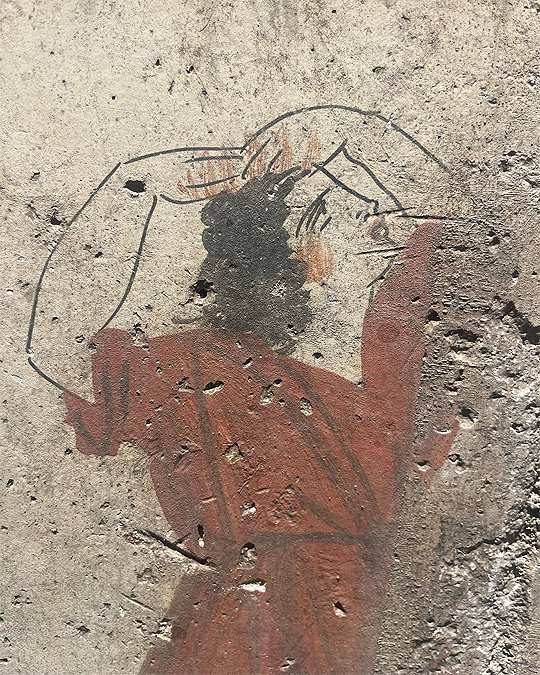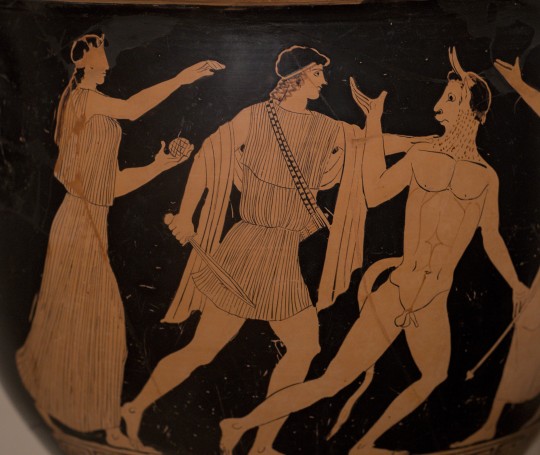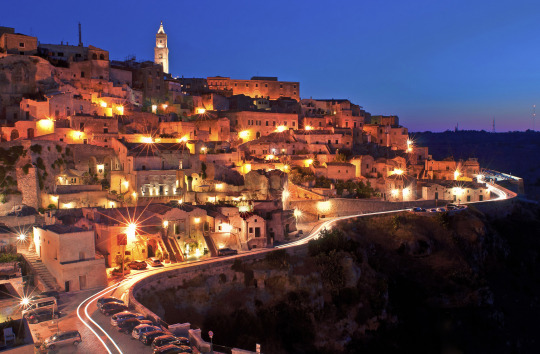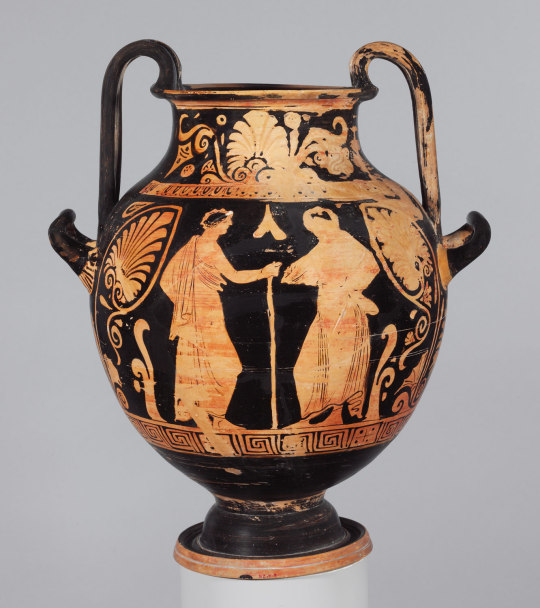#lucanian period
Explore tagged Tumblr posts
Text


Lucanian fresco tomb painting, 4th century BC Museo di Paestum
3K notes
·
View notes
Text

red-figure fish plate | c. 350 - 325 BCE | poseidonia/paestum, magna grecia (modern day italy)
in the j. paul getty museum collection
#magna grecia#ancient italy#classical antiquity#ancient art#antiquity#paestum#technically the lucanians had taken over poseidonia 50 years before this was made. but then what do i say it is? lucanian period?
376 notes
·
View notes
Text


Ariadne
Lucanian Red Figure bell krater representing Ariadne, Theseus and the Minotaur, Classical period, ca.440/20 BCE.
ETRU Museo Nazionale etrusco di Villa Giulia
125 notes
·
View notes
Text
Discover Matera, Italy Explore the Ancient Cave City

Matera, a timeless city in southern Italy, is one of the most unique and ancient destinations in Europe. With its historic cave dwellings carved into limestone cliffs, Matera offers an experience like no other. Dubbed the “City of Caves”, it is one of the oldest continuously inhabited cities in the world, and its extraordinary landscapes are unlike any other. For travelers seeking history, culture, and unforgettable landscapes, Matera is the place to be.
Why Visit Matera?
Matera’s allure lies in its history, architecture, and distinctive charm. As one of the most fascinating cities in Italy, here’s why it’s a must-see:
🌿 Unique Architecture — Matera is known for its ancient cave dwellings and stone-carved structures, collectively known as the Sassi di Matera. These homes were built into the natural limestone rock and have been continuously inhabited for over 9,000 years. 🏰 Rich History — Matera’s history dates back to prehistoric times, and the city has witnessed countless civilizations. From ancient Greek settlers to Norman invaders, Matera’s history is imprinted in its caves and architecture. 🎬 Cultural Significance — Matera was named the European Capital of Culture 2019, celebrating its cultural heritage, which includes art, music, and historical traditions.
Top Sights in Matera
1. Sassi di Matera The Sassi di Matera, the heart of the city, is a UNESCO World Heritage site that consists of two main districts — Sasso Caveoso and Sasso Barisano. These cave dwellings were used by residents for centuries and still hold remnants of ancient life. Walk through the narrow streets to discover ancient churches, homes, and stone-carved buildings.
2. Matera Cathedral Atop Civita Hill, the Matera Cathedral offers stunning views over the Sassi and the Murgia plateau. Built in the 13th century, this Romanesque cathedral boasts beautiful frescoes, a grand altar, and an impressive bell tower.
3. Casa Grotta di Vico Solitario For an insight into life in the caves, visit Casa Grotta di Vico Solitario, a traditional cave house furnished as it would have been in the 18th century. Explore its kitchen, bedrooms, and living spaces to understand how people lived in this unique environment.
4. Rock Churches of Matera The Rock Churches of Matera are fascinating ancient sites carved directly into the rock. Many of these churches date back to the 8th century and feature beautiful frescoes, religious artifacts, and secret chapels. Visit Santa Maria de Idris and San Giovanni in Monterrone for an unforgettable experience.
5. Palombaro Lungo One of the most unique features of Matera is its underground water cisterns, and Palombaro Lungo is the largest. This underground reservoir was used to collect rainwater to sustain the city’s inhabitants during dry periods.
Things to Do in Matera
1. Take a Walking Tour A guided walking tour is the best way to fully immerse yourself in the history and charm of Matera. Visit its ancient cave dwellings, explore its churches, and learn about its rich heritage.
2. Explore Matera’s Artisan Shops Matera is home to many artisan shops selling handmade goods such as ceramics, woven textiles, and traditional foods. Take home a piece of Matera’s culture by visiting its local markets and boutiques.
3. Visit the Matera Museum The Museo Nazionale d’Arte Medievale e Moderna della Basilicata is a great place to learn about Matera’s history and cultural significance. The museum features art from the Medieval and Modern periods, as well as exhibits on the city’s evolution.
4. Dine on Traditional Lucanian Cuisine Matera is also a haven for food lovers. Enjoy traditional Lucanian dishes such as bread (Pane di Matera), oregano, local cheese, and pasta. Stop by one of the many family-run trattorias to savor regional delicacies.
Best Time to Visit Matera
The best time to visit Matera is in the spring and fall, when the weather is mild and the city is less crowded. The summer months can be hot, so early spring or late autumn are ideal for exploring the city’s ancient streets.
Why Matera Should Be on Your Travel List
Matera is a city that offers more than just its unique caves and historic buildings. It’s a place where you can experience the richness of history, the warmth of local culture, and the charm of timeless landscapes. Whether you’re exploring its ancient districts, wandering through underground caverns, or savoring delicious food, Matera is an unforgettable destination.
To learn more about this stunning city, check out World Travel Eye for more tips and guides!
0 notes
Note
I'm back with some additions!
When I first replied to this ask, I was very frustrated because I wanted to add a short documentary made by Luigi Di Gianni about a folk magic practitioner working in Naples, but at the time I couldn't find it. I went back through my old anthropology notes recently and found it: "L'Attaccatura" 1971, again it's in Italian and there are no subtitles, but it's a fascinating watch. In the documentary you actually get to see her perform various rituals including healing/ cleansing rituals, binding, and reading tarot. It's one of my favorite primary sources!
I also wanted to add Maggio Di Accettura to the list of festivals and traditions. It's a ritual that's been practiced every spring for more than 1000 years in which two trees get married. It's a great example of blending something very clearly pagan with Catholicism. Another interesting folk practice from southern Italy the Calabrian Lent tradition of Corajisima. Also of note would be the gioco della falce (game of the sickle) and Lucanian wheat festivals.
As a cool little bonus, I thought I'd mention Alessia Rollo. She is a Southern Italian photographer and artist who has been documenting folk-magic aspects of Southern Italian culture. I just think her work is really cool. Lastly, I recently came across this book: "Performing Ecstasies Music, Dance, and Ritual in the Mediterranean" (which I admittedly haven't fully read through) but it covers a wide variety of topics, time periods, and practices around the Mediterranean with contributions by my evergreen favorite Sabina Magliocco.
If I come across anything new or remember something else, I'll make sure add them to this post!
Hello! I am just starting my journey on reconnecting with my traditional roots as an Italian practitioner. My great grandparents came from Italy in the mid 1900s, but unfortunately passed before I had the pleasure of asking about their practices. Can I ask a good starting point for someone who is trying to reconnect all on her own?
Hello!
I am so happy that you are wanting to reconnect with your roots! I'm sorry you didn't get the opportunity to ask your grandparents, my deepest condolences for your loss.
In terms of resources, my recommendation for anyone starting out is to go to folklore sources or to read books by authors who don't simply reference other witchcraft authors. I highly recommend reading Italian Folk Magic: Rue's Kitchen Witchery by Mary-Grace Fahrun. It's mostly her personal experience with Italian folk-Catholicism and magic with plenty of anecdotes, recipes, superstitions, and various rituals. I think it's probably the best widely available source out there. She also has a youtube channel! In a similar vein, the website Italian Folk Magic has some great posts about Southern Italian and Sicilian magic.
Other online resources I've found useful are Gail Faith Edwards' writings on Southern Italian healers and folk medicine (it's split into 2 parts–– there's a lot of great information if you're into herbalism/ green witchcraft). I also love this article detailing witchcraft history, superstition, and more throughout Italy. It goes into a lot of detail and has some information about herbal properties and their uses as well.
Here are some festivals and traditions from across Italy tied to folk belief: Focara of Novoli, The Campanacci in Basilicata, The Feast of San Domenico and the Ritual of Serpari of Cocullo, Naca Procession in Southern Italy, Dance of the Devils, Celebration of Santa Lucia, The Feast of Mamma Schiavona––There are many others (mostly Saint feasts) that have pre-Christian roots or have significant rituals attached.
Most information that I have collected comes from anthropological and folklore sources that aren't very accessible. There are some videos available of documentary footage of Italian anthropologist Ernesto de Martino's work detailing folk tradition: here's a clip of La Taranta. This documentary isn't in English, however you can still get a lot out of it even if you don't speak Italian (unfortunately there are no subtitles). The documentarian that worked with de Martino, Luigi Di Gianni gives some of his recollections here. Here is a clip documenting the Feast of Mamma Schiavona. Otherwise, everything else is behind a paywall on sites like jstor, sagepub, and other academic publishers. I would recommend reading anything by anthropologist and folklorist Sabina Magliocco (I have copies of her work), as well as de Martino's Magic: A Theory from the South (which I also have a pdf of). The academic texts can be a little dense and daunting, but they're worth the read.
I have uploaded some of what I have to WeTransfer, but it will only be up for 1 week (until July 10th) so if anyone else would like to download them, you can for a limited time!
#italian folk magic#folk magic#folk traditions#beginner witch#italian witchcraft#witchcraft#witchblr#baby witch#stregoneria#benedicaria#witch tips#witches of tumblr#streghe#grimoire#book of shadows#long post
127 notes
·
View notes
Text


~ Terracotta nestoris (two-handled jar).
Attributed to the Painter of New York 52.11.2
Period: Late Classical
Date: ca. 360–350 B.C.
Culture: Greek, South Italian, Lucanian
Medium: Terracotta; red-figure
#ancient#ancient art#ancient pottery#pottery#terracotta nestoris#late classical period#greek#lucanian#south italy#red-figure#ca. 360 b.c.#ca. 350 b.c#history#archeology#museum
239 notes
·
View notes
Text
Trick or treat: the procession of the dead:
What is the trick or treat? It is the custom of: donating sweets and gifts to masked children. In reality, to find out what lies behind this custom, we will have to cross the paths of Italian folklore in search of the "processions of the dead" but also and above all of the "naughty death" of Italian popular traditions. The strange procession is very reminiscent of those Renaissance representations, called "Dances Macabre", which begin to appear around 1400, subsequently interpreted with the motif of "leveling" death. The protagonist is Death who, playing the flute, carries away the deceased subsequently interpreted, an image of the democracy of the Black Lady. In reality, Death replaces the flutist as a symbol who, in the pagan tradition, opened there
mischievous "around the coffin of the god in an endless circle. It accompanied the so-called" funeral procession dance and Surely these representations actually draw on even more ancient memories, as the primitive leader of the ranks would testify. In fact, according to ancient traditions, the procession was opened and closed by a mysterious male figure known in northern Italy as "wild man", the first anthropomorphic transposition of the vegetational spirit, as evidenced by his ability to transform himself into an animal.
Unlike what one might think, these demonic, but metaphor of gaiety and vitality. Groups of people screamed, celebrated, jumped and exhibited the processions were not at all gloomy or even less after nudity, running around the countryside leading herdotes masked by the totemic animal of the god, bearers of abboadanza in places and topical moments of the agricultural calendar and liturgical. It was only later, with the advent of Christianity. that these "playful laughs" turned into demonic encounters and, by transfiguring their images and meanings, the fertility rituals ended up being associated exclusively with the orgy and the diabolical, and then became a "wild hunt", or in Italy known by the names of societas, fazmilia, cazze selvarega, cascia selvadega, hunting of the devil or cascia morta. Italic folklore, from the Maritime Alps to the Julian Alps, no longer tells of festive figures, but of sinister shadows, ranks of fairies, infernal dogs with eyes of embers, witches and demons led by a mysterious and arcane figure called "Diana". In reality, the tradition of the "Procession of the dead" and the vision of the same by the peasant people, we still find it in folklore. There are many folk tales of incredible encounters in the countryside with hosts of the dead. In Friuli, for example, it is told of the adventure that happened to a poor monk in 1091 who, walking along a country path, is attracted by strange laments and thus sees a procession. To travel in company he follows her but here, later, he recognizes some
men of his acquaintances who have recently died and in terror runs away. On the other side of Italy, there are numerous testimonies of Lucanian women who in the last century came across what was known as the "mass of the dead". According to these stories, along the dark streets that led the southern peasant women to the working fields, it often happened to see an open and illuminated church and inside damned souls relaying messages for the living.
"... once a foreseen [interview with an inhabitant of the town of Forenza, in Lucania NdA] bet with his master to go and draw water from a fountain far from the town ... of the Tromacchio fountain he saw four people carrying a coffin on their shoulders ... he decided to go to the fountain of spando but even here the path was blocked by the four ... then a priest who had died for some time came to meet him and took him by the hand and told him 'you don't have to make these bets' .."
Still in the Basilicata region, strongly linked to the peasant world, stories swarm, they collected water, in the reflection of the basin they saw strange processions among which they identified some of their dead: a tradition also present in northern Italy. Also in this case the "visions" are united by a particular: they occur only in specific moments of the life of the individual or in particular periods of the year, often coinciding with agricultural holidays and are often the memory of oracular rituals then forgotten. of women who, while the thesis supported by us is that the masked "game" performed by children during the Halloween party is nothing more than the memory of these fertility rituals of the funeral procession of the dying god and subsequently of the ranks of the dead who, from house to house, in fact, they look for their loved ones and their food and finally, as already mentioned, demonized by the Christian religion, transformed into a sort of horror masquerade.

#magic#witch#moon#pagan witch#fantasy#witches of tumblr#witches#wicca#magick#witchythings#halloween2021#halloween#halloween aesthetic
33 notes
·
View notes
Photo

Melfi (Basilicata). Castle. Interior. Museum. The Castle of Melfi houses the National Archaeological Museum of the Melfese, however several rooms are interesting in themselves. The exhibition is located in the two raised floors, the first one is accessed through a large, long and steep flight of stairs, the culmination of which is a painting by an unknown author, with the inscription "Deiparae virgini urbis et arcis tutelari" (The Virgin Mother, protector of the city and fortress). The archaeological evidences found in the Vulture area concern the populations of prehistory, of the Daunian, Samnite, Roman, Byzantine and Norman periods. The museum opened in 1976 and is organized in three rooms. The first two exhibit weapons, material ceramics from the Bronze and Iron Age. The third collects finds from the Neolithic, the Bronze Age and the Iron Age found in the Lucanian towns of Lavello and Banzi. Various paintings belonging to the Doria and the Habsburgs are also exhibited. #museum #interior #melfi #basilicata #archaeological #flightofstairs #virginmother #fortress #vulture #prehistory #daunia #sanniti #bronzeage #ironage #neolithic #lavello #travel #traveling #visiting #instatravel #travelling #tourism #instatraveling #mytravelgram #travelgram #travelingram #massimopistis #sovVERSIvi #ilmiolibro #estremisti Information for the purchase of my new book "Estremisti!": the book at a cost of 12.00 euros (120 pages), can be ordered in bookstores (ISBN 978-88-591-5719-9 - Publisher Aletti) or online on the page http://www.alettieditore.it/emersi/2019/pistis.html from the link below. https://www.instagram.com/p/B7JxLUToo-V/?igshid=1p69b0a68hjs0
#museum#interior#melfi#basilicata#archaeological#flightofstairs#virginmother#fortress#vulture#prehistory#daunia#sanniti#bronzeage#ironage#neolithic#lavello#travel#traveling#visiting#instatravel#travelling#tourism#instatraveling#mytravelgram#travelgram#travelingram#massimopistis#sovversivi#ilmiolibro#estremisti
2 notes
·
View notes
Text
Michael Kors Outlet In Jackson Mississippi
We imagined how people lived here over 2500 years ago, while we stood inside these magnificent temples. We walked along the ancient roads among the foundations of this once major city of Magna Graecia. After two centuries, the city was conquered by the Lucanians. the Romans took over the city and gave the place the name Paestum. Paestum is considered one of the most important archaeological sites from the (Adidas Originals Yeezy Boost 350 V2 Shoes) Greek/Roman period. This is partly due to the well preserved temples but also because of a find in 1968. In that year, the Tomb of the Diver was found. In this tomb, they found the oldest known Greek mural. It is worth mentioning that the newest addition to EVOL LNG's growing mining customer base is Adaman Resources' Kirkalocka Gold Mine. Adaman anticipates it will save more than $2 million per year and reduce (Michael Kors Bags Outlet) greenhouse gas emissions by 25 percent by fuelling the mine's power station with LNG instead of diesel. "Yeezy Boost 350 Cheap", Is closed A reporter account inside Rome, where coronavirus brought the city to a haltThe first sign that things were going to be different on this trip came when we passed through a completely empty (Discount NFL Jerseys) customs hall after having our body temperatures checked by security staff (New Yeezys 2020) wearing masks (Ray ban Sunglasses Outlet) and gloves. When correspondent Matt Bradley arrived from Philadelphia the following morning, the crew on his American Airlines flight handed him a couple of bottles of water as he exited the plane. Former FDA commissioner Scott Gottlieb on Monday warned that the two states could be "new epicenters of spread." THREAD: We update charts daily for Florida, Louisiana, Illinois, and Michigan as epidemic becomes national in scope; new epicenters of spread emerge. "Jordan Shoes For Sale Online", In 1968 they acquired Wilt Chamberlain in a trade from the Philadelphia 76ers that same season they again made it to the NBA finals losing again to the Boston Celtics, however, Jerry West did something never (Air Jordan Shoes For Sale) before done in NBA history winning Finals MVP on the losing team. They made it to the Finals again the next year this time playing the New York Knicks. "Michael Kors Outlet Store", Wow! You know, make fun of Big Country all (Jordan New Release 2020) you want. He's a million aire, and probably couldn't (MK Outlet) care less about your opinion anyway, so go ahead! But to characterize small town folks in this way is offensive and WRONG! Some of the smartest people I know came from a small towns. I got the opportunity to march in the Fiesta Bowl a few years ago, and a full grown adult actually asked me with all sincerity how we learned to march with out any paved roads in Oklahoma. (Cheap Yeezys For Sale) It's this kind of ignorance and discrimination that makes these kinds of stereotypes possible. Again, compatibility has been well thought out here, and the keyboard or mouse cables can only be connected to their respective connectors at the back panel of the computer. Likewise, all other devices connect to the motherboard in a similar manne, so you can expect to fix loose connections or new hardware connections without any compatibility problems. "Coach Outlet Store Online", Luckily, I had similar ideas to the people who created xG (expected goals) as a better, more rational metric of measuring the likelihood of individuals and teams to score goals. After I heard of xG a couple years ago, I was intrigued and was immediately enticed to attempt to replicate these numbers. But unlike major companies like Statsbomb or Opta, I don't have the millions of data points off of thousands of games to analyze. I also don't have a full team of qualified analysts to create sophisticated software to maximize my time in producing these numbers. So (Cheap Jordan Shoes For Men) then, how did I do it.
0 notes
Photo

Thurii - The First Panhellenic City Thurii was a Greek Colony in South Italy, founded in 444 BC on the site of Sybaris. It was a panhellenic foundation, but the main impetus was Athenian. Herodotus and Lysias were reputedly colonists, and it was planned by Hippodamus of Miletus. The constitution of the city was written by the famous philosopher Protagoras from Abdera. There was initial stasis between the surviving Sybarites and the other colonists, but the city flourished. In 390 BC, it was defeated by the Lucanians, and was under pressure from Bruttian raids for most of the 4th century. In the 330s it was the headquarters of the Italiote league for a short time. A rift with Tarentum occured in 282, when Thurii appealed for Roman help against the Lucanians and a Roman garrison was installed. The Tarentines ejected it and the incident contributed to the outbreak of the Pyrrhic War. In 212 BC, Thurii revolted from Rome and joined Hannibal in period of the Punic Wars. A latin colony with the name Copia was later founded there in 193, and continued to exist until late antiquity. #Democracy #protagoras #herodotus #lysias #sybaris #athens #athenian #rome #hannibal #greek #ancientgreece #italy #calabria #magnagrecia #constitution #copia #thurii #archaeology #history #instadaily #instagood #tourist #knowledge #instalike #roman #hellenic #latin #colony #miletus #pyrrhus
#lysias#italy#history#constitution#rome#colony#calabria#instalike#knowledge#greek#democracy#copia#instagood#pyrrhus#thurii#hellenic#archaeology#tourist#roman#sybaris#athens#latin#magnagrecia#instadaily#protagoras#athenian#miletus#hannibal#herodotus#ancientgreece
0 notes
Photo

LUCANIA, Metapontion. Circa 400-340 BC. AR Nomos (7.76 g, 9h). Head of Demeter left / Barley ear of seven grains with leaf to right; ivy leaf above leaf. Noe 521; HN Italy 1545. Near VF, lightly toned, struck from worn obverse die, a few scratches. Rare, Noe records only 2 examples. From the Colin E. Pitchfork Collection. Ex-CNG Metapontum or Metapontium (Ancient Greek: Μεταπόντιον Metapontion) was an important city of Magna Graecia, situated on the gulf of Tarentum, between the river Bradanus and the Casuentus (modern Basento). It was distant about 20 km from Heraclea and 40 from Tarentum. The ruins of Metapontum are located in the frazione of Metaponto, in the comune of Bernalda, in the Province of Matera, Basilicata region, Italy. Though Metapontum was an ancient Greek Achaean colony, various traditions assigned to it a much earlier origin. Strabo ascribes its foundation to a body of Pylians, a part of those who had followed Nestor to Troy; while Justin tells us it was founded by Epeius, the hero who constructed the wooden horse at Troy; in proof of which the inhabitants showed, in a temple of Minerva, the tools used by him on that occasion. Another tradition, reported by Ephorus, assigned to it a Phocian origin, and called Daulius, the tyrant of Crisa near Delphi, its founder. Other legends carried back its origin to a still more remote period. Antiochus of Syracuse said that it was originally called Metabus, from a hero of that name, who appears to have been identified with the Metapontus who figured in the Greek mythical story as the husband of Melanippe and father of Aeolus and Boeotus. At the time of the Athenian expedition to Sicily, 415 BCE, the Metapontines at first, like the other states of Magna Graecia, endeavoured to maintain a strict neutrality; but in the following year were induced to enter into an alliance with Athens, and furnish a small auxiliary force to the armament under Demosthenes and Eurymedon. It seems clear that Metapontum was at this time a flourishing and opulent city; nor have we any reason to suppose that its decline began until long after. From its position it was secured from the attacks of Dionysius of Syracuse; and though it must have been endangered in common with the other Greek cities by the advancing power of the Lucanians, it does not appear to have taken any prominent part in the wars with that people, and probably suffered but little from their attacks. Its name is again mentioned in 345 BCE, when Timoleon touched there on his expedition to Sicily, but it does not appear to have taken any part in his favour. In 332 BCE, when Alexander, king of Epirus, crossed over into Italy at the invitation of the Tarentines, the Metapontines were among the first to conclude an alliance with that monarch, and support him in his wars against the Lucanians and Bruttians. Hence, after his defeat and death at Pandosia, 326 BCE, it was to Metapontum that his remains were sent for interment. But some years later, 303 BCE, when Cleonymus of Sparta was in his turn invited by the Tarentines, the Metapontines, for what reason we know not, pursued a different policy, and incurred the resentment of that leader, who, in consequence, turned his own arms, as well as those of the Lucanians, against them. He was then admitted into the city on friendly terms, but nevertheless exacted from them a large sum of money, and committed various other excesses. It is evident that Metapontum was at this period still wealthy; but its citizens had apparently, like their neighbors the Tarentines, fallen into a state of slothfulness and luxury, so that they were become almost proverbial for their lack of vigor.
0 notes